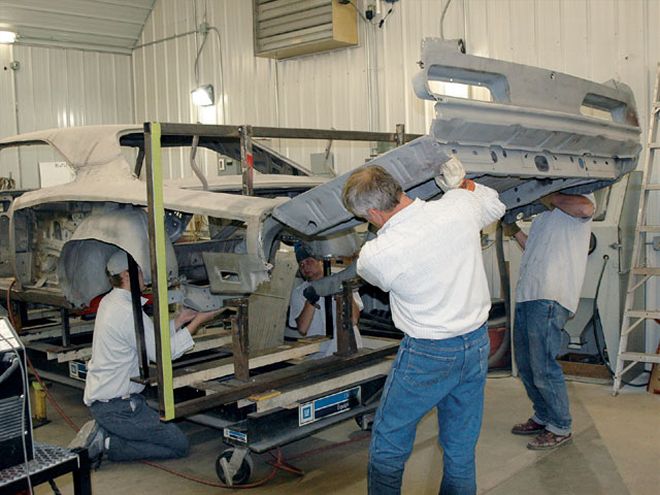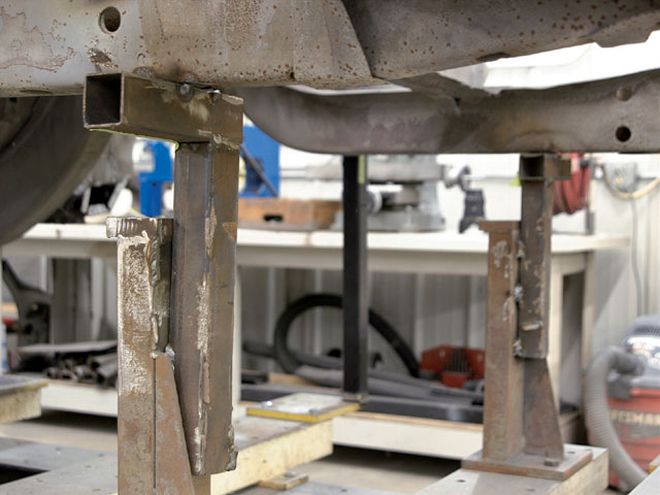
 Any car that needs framerails will also have extensive rust damage elsewhere. This one needed a new rear tailpanel, so the decision was made to remove it along with the frame. You'll see why that was done as we get further into the project.
Any car that needs framerails will also have extensive rust damage elsewhere. This one needed a new rear tailpanel, so the decision was made to remove it along with the frame. You'll see why that was done as we get further into the project.
None of us like to think about this, but most of our favorite musclecars are rapidly approaching 40 years old. even though it's getting harder and harder to find complete original cars, and even though the prices for what we do find aren't going down, it's actually easier than ever to restore the car of your dreams. There are more parts and services available now then ever before.
However-and there is just no getting around this-we are starting to run out of some of the rarer versions of the cars we love. Guys are restoring cars today that just a few years ago would have been considered too far gone to fix. Cars that would have been crushed and scrapped for the steel, or at best used for parts, are now being fully restored.
The 69 1/2 Super Bee you see here is a prime example. As an original A12 car, it's a rare find. The "Catch 22" is these cars are still around because they are rare, but too far gone for most guys to deal with. This one was straight and mostly complete, but had extensive rust damage. In addition to the usual rust prone areas, this one also had to have new rear framerails-a job a lot more demanding than tacking on some new quarters.
Still, this sort of thing is not beyond many do-it-yourselfers. You'll need to be proficient with welding sheetmetal, have a large clean work space, two or three extra pairs of hands, and plenty of patience, but with some expert tips to help keep you out of trouble, we know you can do this.
 Before any cutting of sheetmetal or framerails can begin, you must make sure the body is securely fastened to a supporting system and perfectly level. You must ensure the remaining body retains its exact original shape. At MCR, a frame jig is available, but we know you probably won't have access to that kind of equipment. What you can do is make stands for square stock, much like the units that are part of the jig. If you can get a set of jackstands to perfectly level the car, that'll work too. Just put a small tack weld on the stand where it meets the car to ensure it doesn't move. Also mark the stand's location on the floor; that way if the stand gets moved somehow, you can put it back.
Before any cutting of sheetmetal or framerails can begin, you must make sure the body is securely fastened to a supporting system and perfectly level. You must ensure the remaining body retains its exact original shape. At MCR, a frame jig is available, but we know you probably won't have access to that kind of equipment. What you can do is make stands for square stock, much like the units that are part of the jig. If you can get a set of jackstands to perfectly level the car, that'll work too. Just put a small tack weld on the stand where it meets the car to ensure it doesn't move. Also mark the stand's location on the floor; that way if the stand gets moved somehow, you can put it back.
When it comes to advanced restoration metal work, we don't know of anyone more experienced than the guys at Muscle car Restorations (MCR) in Chippewa Falls, Wisconsin. Owner John Balow got his start working on Mopars when there weren't the resources available like there are today. he and his team have been doing this kind of thing for almost two decades, and they know where to find the donor cars to supply the needed parts.
In a nutshell, the critical part of this kind of job is keeping everything square. We don't have to tell you the kind of drivetrain/tracking problems one could create if the frame isn't plumb with the rest of the body. While the guys at MCR use a professional frame rack that easily allows them to weld-in all the braces and supports needed to keep everything in place and provide reference points for reassembly, this job can be done on a flat concrete floor if one takes the time to fabricate the necessary supports and measure several times.
If there is a trick to this kind of work, in addition to properly supporting and bracing delicate areas, it's in taking and recording a lot of measurements and marking key reference points so you have a way of verifying that the new rails are in exactly the right place. This assumes your car is straight to begin with. If it's not, you'd better back up and get that issue straightened out first (pun intended). Another key tip is to replace both the rails as a unit with all their factory bracing intact. That way you won't be as likely to get the rails skewed with each other, and your rear suspension will bolt-up perfectly.
When we showed up at MCR for photos, the car had already been dipped to remove the many years of rust and other crud, and a lot of the prep work was underway. The framerails are not usually the first things to come out during a project like this. Removing the quarters and the trunk floor makes access to the attachment points much easier. the inner rockers on both sides were already replaced, so there would be solid mounting points available when the new rails were fitted in place.
Now, we may be doing this job to a B-Body, but the steps shown here can be used on any Mopar's rear frame if it needs replaced. Ok, are you ready? Take a deep breath and let's have at it. By the time we're done, you'll know what you are doing.